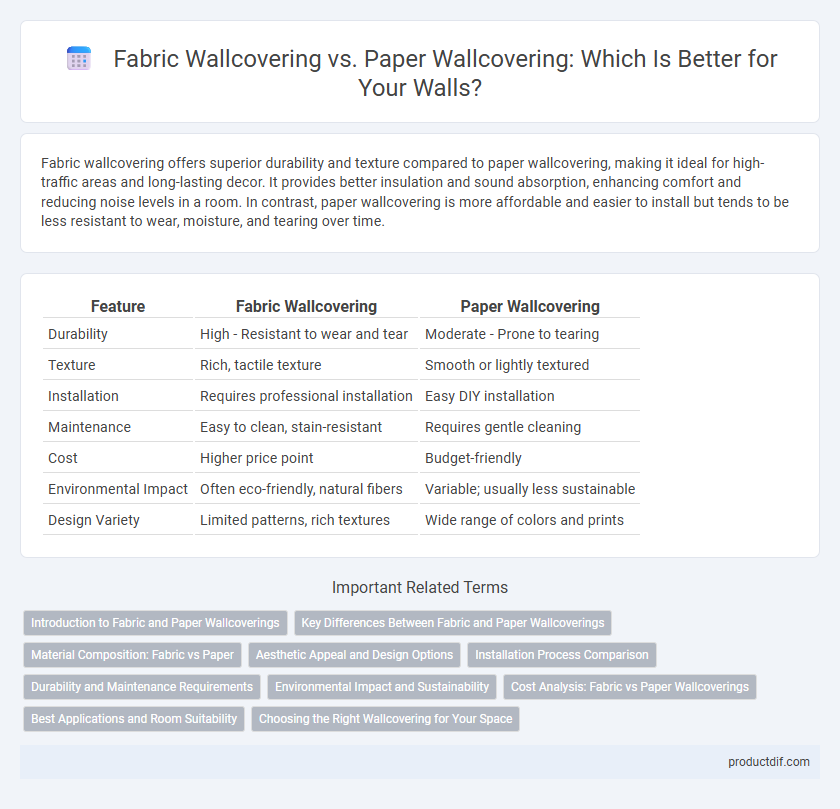Fabric wallcovering offers superior durability and texture compared to paper wallcovering, making it ideal for high-traffic areas and long-lasting decor. It provides better insulation and sound absorption, enhancing comfort and reducing noise levels in a room. In contrast, paper wallcovering is more affordable and easier to install but tends to be less resistant to wear, moisture, and tearing over time.
Table of Comparison
| Feature | Fabric Wallcovering | Paper Wallcovering |
|---|---|---|
| Durability | High - Resistant to wear and tear | Moderate - Prone to tearing |
| Texture | Rich, tactile texture | Smooth or lightly textured |
| Installation | Requires professional installation | Easy DIY installation |
| Maintenance | Easy to clean, stain-resistant | Requires gentle cleaning |
| Cost | Higher price point | Budget-friendly |
| Environmental Impact | Often eco-friendly, natural fibers | Variable; usually less sustainable |
| Design Variety | Limited patterns, rich textures | Wide range of colors and prints |
Introduction to Fabric and Paper Wallcoverings
Fabric wallcoverings offer a textured surface made from natural fibers like silk, linen, or cotton, providing durability and a luxurious aesthetic ideal for high-end interiors. Paper wallcoverings, typically crafted from vinyl-coated or embossed paper, deliver affordability and a wide range of patterns suitable for various design styles. Both options serve distinct functional and decorative purposes, with fabric wallcoverings excelling in elegance and durability, while paper wallcoverings offer versatility and cost-effectiveness.
Key Differences Between Fabric and Paper Wallcoverings
Fabric wallcoverings offer enhanced durability and texture, providing a rich, tactile surface ideal for high-traffic areas, whereas paper wallcoverings are generally thinner and more affordable, suited for low-traffic or temporary decor. Fabric options typically resist wear and stains better and can add acoustic benefits, while paper coverings allow for more intricate printed designs and are easier to replace. Maintenance differs as fabric requires gentle cleaning methods, whereas paper wallcoverings are more susceptible to moisture and tearing.
Material Composition: Fabric vs Paper
Fabric wallcoverings are composed of woven textiles such as silk, linen, or cotton, providing a textured, durable surface with enhanced acoustic and thermal properties. Paper wallcoverings, made primarily from cellulose fibers, offer a smoother finish and are typically less durable but more cost-effective and easier to replace. The intrinsic material differences impact installation methods, maintenance requirements, and overall longevity in interior design applications.
Aesthetic Appeal and Design Options
Fabric wallcoverings offer a rich, textured aesthetic that enhances depth and warmth in interior spaces, often available in diverse weaves, patterns, and finishes for a luxurious appearance. Paper wallcoverings present a wide range of printed designs, from intricate patterns to bold graphics, providing versatile and cost-effective options that suit various decor styles. Both materials enable customization, but fabric options tend to deliver a more sophisticated and tactile finish, while paper offers greater flexibility in color and detailed artwork.
Installation Process Comparison
Fabric wallcovering installation typically requires skilled handling due to its heavier weight and delicate texture, often needing specialized adhesives and precise stretching for a smooth finish. Paper wallcovering is generally easier to install, using standard paste and simpler application techniques, making it more suitable for DIY projects. Proper surface preparation is crucial for both, but fabric wallcovering demands more time and expertise to avoid wrinkles and achieve a professional appearance.
Durability and Maintenance Requirements
Fabric wallcoverings offer superior durability compared to paper wallcoverings due to their thick fibers and resistance to tearing. They require minimal maintenance, often needing only gentle vacuuming or occasional spot cleaning to preserve their texture and appearance. Paper wallcoverings, while less durable and prone to damage from moisture, need more frequent replacement and careful handling during cleaning to avoid tearing or discoloration.
Environmental Impact and Sustainability
Fabric wallcoverings often have a higher environmental impact due to resource-intensive production and difficulty in recycling, whereas paper wallcoverings generally offer greater sustainability through biodegradability and easier recyclability. Natural fiber fabrics can sometimes provide eco-friendly options if sourced responsibly, but synthetic blends usually increase carbon footprint and landfill waste. Paper wallcoverings made from recycled materials or sustainably harvested pulp reduce deforestation and minimize ecological damage compared to conventional fabric options.
Cost Analysis: Fabric vs Paper Wallcoverings
Fabric wallcoverings generally incur higher initial costs compared to paper wallcoverings due to premium materials and complex manufacturing processes. Maintenance expenses also differ; fabric requires specialized cleaning, increasing long-term costs, whereas paper is easier and cheaper to replace or repair. For budget-conscious projects, paper wallcoverings offer cost-effective options, but fabric wallcoverings provide durability and aesthetic value that may justify the higher investment.
Best Applications and Room Suitability
Fabric wallcoverings are best suited for living rooms, bedrooms, and dining areas due to their durability, texture, and sound-absorbing qualities that enhance comfort and luxury. Paper wallcoverings work well in low-traffic spaces such as guest rooms, closets, or accent walls where ease of installation and budget are priorities. Fabric excels in high-moisture resistance and longevity, making it ideal for spaces requiring both aesthetic appeal and practical durability.
Choosing the Right Wallcovering for Your Space
Fabric wallcoverings offer enhanced durability, texture, and sound absorption, making them ideal for high-traffic or cozy living spaces. Paper wallcoverings provide affordability and ease of application, perfect for temporary or budget-conscious projects. Selecting the right wallcovering depends on factors such as room usage, desired aesthetic, maintenance requirements, and budget constraints.
Fabric Wallcovering vs Paper Wallcovering Infographic

 productdif.com
productdif.com